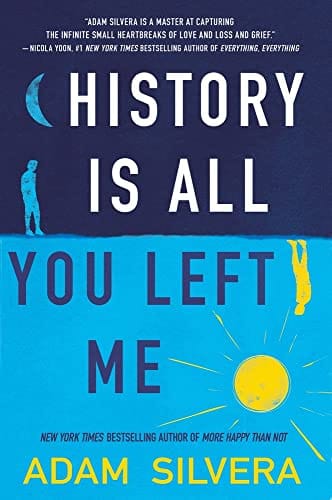An In-Depth Look at “History Is All You Left Me”
Explore the plot, themes, and impact of Adam Silvera’s History Is All You Left Me in this 800-word guide to grief, love, and LGBTQ+ representation.

Introduction
History Is All You Left Me is a 2017 young-adult novel by Adam Silvera that has resonated with readers for its raw depiction of love, loss, and the complicated process of learning to live with grief. Combining contemporary realism with a unique dual timeline, the book explores how the past and present collide when we lose someone we believed would always be part of our future. In roughly 300 pages, Silvera crafts an emotionally charged story that has become a staple on LGBTQ+ reading lists and has cemented his reputation as a leading voice in modern YA fiction.
Plot Overview
The novel follows Griffin Jennings, a New York teen whose life is upended when his ex-boyfriend and best friend, Theo McIntyre, dies in a drowning accident while studying on the West Coast. Although Griffin and Theo had broken up before the tragedy, Griffin still believed they would ultimately end up together. The narrative switches between two timelines: “History,” which chronicles Griffin and Theo’s relationship from their first meeting to their painful breakup, and “Today,” which captures Griffin’s spiraling grief in the aftermath of Theo’s death.
Complicating matters further, Griffin forms an uneasy alliance with Jackson, Theo’s last boyfriend in California. Both young men feel that the other stole valuable time with Theo, yet each is also the only person who truly understands the depth of the other’s loss. Their bond becomes a catalyst for confronting uncomfortable truths about Theo, their relationships, and themselves.
Themes and Motifs
Grief and Mental Health
History Is All You Left Me offers a painfully honest portrayal of grief. Griffin’s obsessive thinking, intrusive memories, and descent into unhealthy coping mechanisms feel authentic, reflecting Silvera’s commitment to depicting mental health without romanticization. The book underscores that mourning is non-linear; setbacks coexist with moments of healing.
First Love and Second Chances
Silvera captures the exhilaration of first love alongside the heartbreaking realization that even the strongest bonds can fracture under real-world pressures. Griffin and Theo’s relationship evolves from friendship to romance to estrangement, highlighting how expectations, distance, and personal growth can reshape affection.
Memory and History
The title itself alludes to the way memories can both comfort and torment. While Griffin cherishes the “history” he shared with Theo, those same recollections trap him in a cycle of regret. Silvera suggests that reclaiming the future requires deciding what parts of history to carry forward.
Character Analysis
Griffin Jennings
As narrator, Griffin is endearing yet frustrating, a realistic depiction of a teenager overwhelmed by loss. His compulsions—including counting steps and arranging objects symmetrically—hint at underlying OCD, further complicating his grief journey. Because Griffin speaks directly to Theo throughout the book, readers experience his guilt and longing firsthand.
Theo McIntyre
Even in death, Theo feels vibrant. Flashbacks show a brilliant, astronomy-obsessed dreamer whose ambition sometimes blinds him to Griffin’s insecurities. Silvera avoids idealizing Theo; instead, he presents a flawed teen whose decisions leave lasting repercussions.
Jackson Wright
Initially positioned as Griffin’s rival, Jackson gradually emerges as a mirror for Griffin’s pain. Their evolving friendship demonstrates that shared grief can bridge seemingly insurmountable divides and foster personal growth.
Narrative Structure
The alternating “History” and “Today” chapters drive suspense, revealing critical information about Griffin and Theo’s breakup at a pace that mirrors Griffin’s internal processing. This fragmented structure mimics the disorientation of loss—memories intrude at random, forcing the present to pause while the mind reels backward.
Silvera’s choice to have Griffin address Theo directly in second person intensifies intimacy and immediacy. Readers become co-confidants, privy to thoughts Griffin withholds from living characters. The technique also spotlights one of the book’s central questions: How do we talk to someone who is no longer there?
Representation and Impact
One reason History Is All You Left Me garners praise is its nuanced LGBTQ+ representation. The novel moves beyond the typical coming-out arc to focus on universal themes—grief, jealousy, friendship—through a queer lens. Silvera’s characters are multidimensional youths whose sexualities are integral yet not defining. For many readers, especially queer teens, seeing themselves reflected in complex, heartfelt narratives can be life-affirming.
The book also opens dialogues around mental health. By portraying therapy as a viable tool for recovery, Silvera destigmatizes seeking professional help. Griffin’s trajectory illustrates that acknowledging pain is not weakness but a courageous step toward healing.
Critical Reception
Upon release, History Is All You Left Me debuted on bestseller lists and earned starred reviews from publications such as Booklist and School Library Journal. Critics praised Silvera’s ability to weave poignancy with humor, noting that the book “captures the messy ugliness of grief without foregoing hope.” The novel was a finalist for the Lambda Literary Award in the LGBTQ Children’s/Young Adult category and routinely appears on school and library recommended reading lists.
Why You Should Read It
If you are searching for a young-adult story that transcends genre tropes, History Is All You Left Me delivers an unforgettable emotional experience. Whether you’re drawn to contemporary romance, character-driven narratives, or explorations of mental health, Silvera’s novel offers insight wrapped in lyrical prose. Readers will likely find themselves reflecting on their own histories—and considering how to move forward after loss.
Final Thoughts
History Is All You Left Me stands out for its bold honesty, innovative structure, and compassionate portrayal of queer teens navigating the universal terrain of grief. Adam Silvera doesn’t promise tidy resolutions; instead, he offers readers the harder but truer message that healing is an ongoing process shaped by the histories we choose to honor and the futures we dare to imagine. For anyone who has loved deeply and lost, this novel affirms that while history may be all we have left, it can also be the foundation on which we build new stories.



